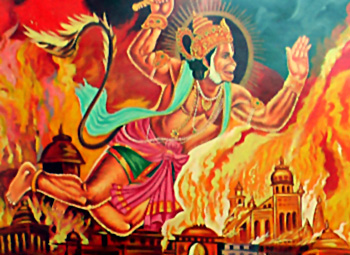 Hanuman burns Lanka after his tail was set fire on the orders of Ravana. Hanuman met Sita in the Ashoka Vatika and exchanged words with her regarding Rama and Lakshmana and also enquired about her state there. He also gave her the token given by Rama, the signet-ring. He also asked for a token from Sita so that he could present the same to Rama after he returns from Lanka. However, Hanuman was not only satisfied after he met Sita and dashed about the Ashoka grove and broke the trees and spoiled the pavilions with the power of the wind.
Hanuman burns Lanka after his tail was set fire on the orders of Ravana. Hanuman met Sita in the Ashoka Vatika and exchanged words with her regarding Rama and Lakshmana and also enquired about her state there. He also gave her the token given by Rama, the signet-ring. He also asked for a token from Sita so that he could present the same to Rama after he returns from Lanka. However, Hanuman was not only satisfied after he met Sita and dashed about the Ashoka grove and broke the trees and spoiled the pavilions with the power of the wind.
When the rakshasis in the Ashoka Vatika saw the monkey with tremendous energy destroying the beautiful place, they sent messages to Ravana for help, and the demon king, hearing that a mighty monkey was destroying his servants, sent the powerful Jambumali, bow in hand, to slay Hanuman forthwith; and, he also wounded him with a sharp arrow as he sat upon a temple roof, but Hanuman immediately hurled a bolt at him and crushed him utterly. After that came a host of heroic rakshasas, led by Prince Aksha and met their death after confronting with Hanuman.
At last Indrajit was sent to fight against Hanuman, and an awful battle took place, whereat even the gods were amazed. Indrajit sent a million shafts against the monkey, but he, easily escaped them all. Then Indrajit paused, and with concentrated mind thought over the true character of Hanuman, and with spiritual penetration perceived that hanuman was not to be slain by weapons. Thus, he invented a mode to bind him, and he directed a Brahma shaft at Hanuman. Hanuman was bound, and he knew the bond unbreakable, and therefore fell to earth. He however reflected that it would be nice for him to meet Ravana, and therefore he did not show any resistance, but let the rakshasas bear him off.
But the rakshasas seeing Hanuman still bound him yet closer, pitifully moaning the while, with cords and bark and that binding was the means of his release, since the binding power of a Brahma weapon breaks at once if another bond is added to it. However, Hanuman gave no sign that the bonds were loosed while the fierce rakshasas, crying to each other, dragged him before Ravana. When questioned by the ministers of Ravana, Hanuman answered that he was merely a monkey, came to Lanka, as an envoy of Rama to carry out his commands and to find out Ravana. The he told the story of Rama up till then, and advised Ravana to save his life by surrendering Sita to Rama. Ravana became very furious and would have attempted to kill Hanuman, but the counselors reminded him that death punishment could not justly be inflicted upon some one who named himself an envoy.
Then Ravana cast about for a penalty, and ordered his rakshasas to set the tail of Hanuman on fire. Then the rakshasas bound his tail with cotton soaked in oil and set it all ablaze. But the great monkey treasured a secret plan; he suffered the rakshasas to lead him about Lanka that he might the better learn its ways and strength. The news of the setting of Hanuman`s tail on fire reached Sita and that he was a spy. After hearing this she grieved, and prayed to the Fire, to save the innocent Hanuman from any injury or burns. The Fire flamed up in response to her prayer, and the very moment the sire of Hanuman blew cool between Hanuman and the flame. Finding that the fire still burnt, but he was not able to receive any pain or injury, Hanuman thought that it was for the sake of Rama and Sita, and he snapped his bonds and sprang into the sky, huge as a mountain, and rushed to and fro in Lanka, burning the palaces and all their treasures. And when he had burnt half Lanka to the ground and slaughtered a large number of rakshasas, Hanuman quenched his tail in the sea.












